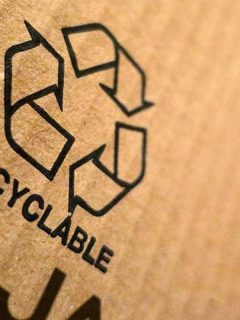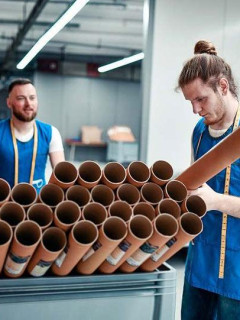experienced this while washing up: you’re just a little too rough and… Gling! Your glass breaks. Then imagine the consequences that sending glass or china can have if you have an online shop. Your customers expect their purchase to reach them in perfect condition, so using the right packaging is a must. Boxes, tapes, labels, bubble wrap… They all contribute to the safe transport of your fragile products.
►step 1: Which crate or box is suitable for glass or porcelain?
[The crate and the box play a major role in this story. Hence the first rule: always use a new crate or box. Even if a used crate or box is still in good condition, this does not guarantee that the internal structure is intact. Here are some important points of attention
- Choose a crate with a kraft paper outer cover. This cover is more resistant to moisture and your tape will also adhere more easily (for more information, see step 3).
- Preferably ship glass or china in a double-wall cardboard box. The thicker structure of the cardboard provides better protection. Read all about the difference between a single and double-wall cardboard box.
- Choose a custom-made box, for example, there are standard boxes for mugs, wine bottles, plates, glasses, etc. The advantage is that you often no longer need additional protective material.

►step 2: How to choose the right protective material?
For those using a custom box, this second step may be less applicable.If you are using a “normal” box, you will probably need to protect your product even more.We will help you understand with an example.For the occasion, we have taken a teapot
- [1 ] Any empty space inside your product should be filled, for example, you can fill the inside of your teapot with wrapping paper.
- [2] The ends of the product are particularly vulnerable, so in our example we’re going to wrap the spout and handle more to create a single shape with the body and lid of the teapot. One important rule: if the surface is sensitive to scratches, use foam film. For less sensitive products, you can also choose bubble wrap or even wrapping paper.
- [3] Next, wrap the entire teapot generously with film (foam, bubble or paper) – again, it is best to use foam film for a scratch sensitive surface.
- [4] Finally: provide the bottom of your box with a layer of cushioning material. Then put your product on top of it. Fill in all the remaining empty space. Your product should not be able to move anymore. It is best to use bubble wrap or cushioning paper.

► Step 3: How do I close my box?

Il y a trois façons de fermer une caisse, comme vous pouvez le voir sur l’image ci-dessous. Tout d’abord, vous avez la forme régulière du “U” (1). Vous pouvez également choisir la “double forme en U” (2) et la “forme en H” (3). Ces deux dernières sont les plus sûres et sont fortement recommandés pour les chargements plus lourds ou fragiles. N’oubliez pas de lire la suite pour savoir comment appliquer au mieux les rubans adhésifs.
Avez-vous un doute entre le ruban adhésif PP et PVC ? N’oubliez pas que le ruban adhésif PP est mieux adapté aux colis légers (jusqu’à environ 20 ou 30 kg). Le ruban adhésif PVC est lui généralement recommandé pour les colis lourds (jusqu’à 40 kg). Au fait, votre caisse a-t-elle une couche extérieure de papier kraft? Si c’est le cas, cela vous donnera un avantage supplémentaire en matière de fermeture. Les fibres du papier kraft sont plus neuves et plus longues, ce qui rend la surface plus plate. Cela permet à l’adhésif du
ruban d’adhérer beaucoup
► Step 4: Which packaging labels are essential?
A wise man is worth two. Throughout the shipping process, it is best to clearly indicate that the contents of your package are fragile.For products such as glass or porcelain, there are specific and suitable labels
for
this purpose.Below are some images of the most commonly used variants.What is the best way to stick such a label on your crate? We have these 4 tips for you
- Stick the label on the side of your parcel, not on the top. Parcels are often transported in stacks, so the labels on the top are no longer visible.
- Don’t stick labels on a fold or corner – this makes the label harder to read and the barcode harder to scan. Don’t stick the label on the tape – opening the parcel may damage the label
- Always stick a warning label on the largest surface of the package. This increases the chances of visibility.
- Don’t use more labels than you need – limit yourself to what is necessary (e.g. three labels), as too many labels will make the message look messy.

- Always use a new crate or, better still, a custom-made crate. Your crate should preferably be lined with kraft paper.
- If your product is sensitive to scratches, wrap it in foam film. Otherwise, bubble wrap or wrapping paper may also be sufficient. Next, fix your product firmly in the box.
- Choose a strong adhesive tape and close the box properly.
- Equip your crate with the correct shipping labels so that everyone knows it contains fragile products














